Forewarned is forearmed. Part 3
- Part 1: photosynthesis, all living things breathe, shock measurements .
- Part 2: room ventilation, damage to the assembly, the advantage of two instruments for conducting experiments .
- Part 3: graphics, calibration, analysis of the device, the principle of operation, fermentation.
Soon…
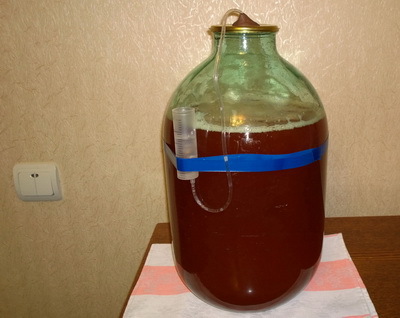
')
38 parrots
The boa in parrots looks much longer, but in our case it is a fairly large unit of measurement. To determine the dimensions of the MT8057 meter, we use the classic matchbox or the usual line: 116x38x24 mm.
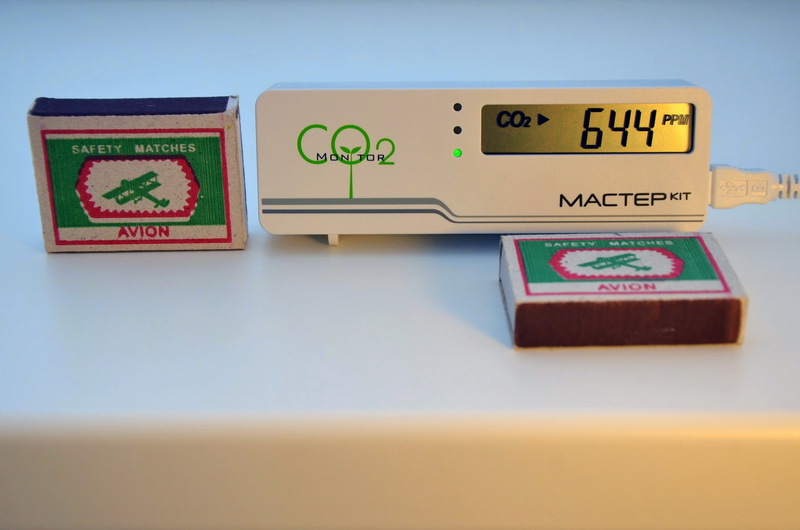
I do not ask you where you were. I ask where you go from!
It turned out that the data from the device can be automatically recorded in a computer and plotted to determine exactly where the concentration of carbon dioxide comes from.
It was discovered by chance. When connecting power from the USB port, the computer said: “Dzin-dzin!”
The device, I thought, and not mistaken. The search for the driver resulted in two slightly different versions of the program for working with this device.
With the help of the program you can see the real and archive values, configure the program and calibrate the device, get the table values of the measured parameters.
The program has been tested on Windows XP and 7.
He knows little, but for sure!
There are many devices that differ in measurement accuracy, functionality and price accordingly.
Therefore, to please everyone is too expensive! Using the example of experiments and graphs, it is shown that in most cases 100 ppm accuracy is sufficient for domestic use, especially since there are such phenomena as the lack of factory calibration of instruments from some manufacturers, natural care of the sensor readings, lack of access to reference air for manual calibration, triggered automatic calibration in the room where airing is not performed, the unstable content of carbon dioxide in the street air used for the standard * .
The influence of these factors in some cases totally exceeds the accuracy of measurement of extremely accurate devices and does not allow to determine the true concentration after some time of operation. If there are doubts about the accuracy of the readings, then the instrument can be calibrated.
Calibration
As a result of natural care, the sensor readings with prolonged use of the device may deviate from the true value. To get them back to normal, they calibrate — they tell the device that the value that it now “sees” is true. The deviation can be noticed with good ventilation, when the concentration should drop to about 400 ppm * .
Calibration is manual and automatic.
Manual is made using the program.
As a source of reference carbon dioxide content, a 1000 ppm balloon can be used, any other source with a stable concentration (its value is indicated in the settings window) or outside air — it is believed that it has about 400 ppm * .
You can calibrate on any other device that has high accuracy by placing them in one sealed bag. After the cessation of changes in readings (approximately 30 minutes), the reference device is recorded by the program to the device under test.
If outdoor or other air is used through the openings in the instrument case, then calibrate for about 30 minutes.
If the source of the reference gas is connected to the calibration hole (on the case of the device, the input is located next to the USB connector) and the gas enters directly to the sensor through a special tube, the calibration process lasts 5 minutes.
Automatic on / off in the device menu “8bc”. It is believed that at least once a week the room was aired and outside air with a “reference” concentration of 400 ppm * reached the device. When you turn on this mode, the device counts the days of its work and records the minimum measured value of the concentration of carbon dioxide. This minimum value is taken as a reference. With large deviations of the former reference value and the newly measured, a significant jump in the indications is possible. To prevent this from happening, the former value is changed by no more than 30 or 50 ppm (the exact value can be obtained from the manufacturer or can be found by observing changes in the indications).
If the room is not ventilated, it is advisable to disable the automatic calibration. If an adjustment has already occurred, you can always reset to the factory settings and, if necessary, perform a manual calibration.
* Doubts about the benchmark 400 ppm.
1. The recently announced results of changes in carbon dioxide concentration throughout the year, shown in NASA’s “ A Year in the Life of Earth’s ” CO2 film, cast doubt on the usefulness of using outdoor air as a reference for 400 ppm, especially for instruments with high accuracy.
2. The concentration of carbon dioxide on the planet changes cyclically over the years, now we are on the rise.

3. The Keeling schedule in recent years has become quite dynamic, and the background concentration during the lifetime of the device can change significantly.

4. Measurements for the Keeling schedule are carried out on Mauna Loa Mountain, the island of Hawaii. But the concentration of carbon dioxide depends on the amount of air emissions in a particular place. Therefore, in rural areas, the background value is one, in small towns it is another, in large cities - the third.
5. The level of carbon dioxide concentration depends on the direction and speed of the wind - this can explain the fluctuations of the background value in large cities.
If the car with the letter "U" turned on the wipers, it means that it will now turn
In the test samples, the wipers never turned on.
The device's screen for 15 seconds shows the carbon dioxide content, then for 5 seconds the air temperature.
The traffic light to the left of the indicator lights its “red-yellow-green”, which is quite enough to assess the state of the air when monitoring from a long distance - a good solution for an instant assessment of the carbon dioxide concentration.
Using the “Mode” and “Enter” buttons located on the back of the device, various setup information can be displayed on the screen:
“ ALEI ” - height above sea level at the point of measurement. The adjustment is from 0 to 9900 m, the tuning step is 100 m, the default is h = 0 m.
Setting for a more accurate measurement, since when the pressure (height) changes, the readings need to be adjusted.
Example: the device was in a sealed bag and at h = 0 m showed a concentration of 664 ppm. After setting the height to 9900 m, the readings changed to 2050 ppm.
“ ALARM 1 ” - setting the first alarm level: yellow LED signal, default 800 ppm.
“ ALARM 2 ” - setting the second alarm level: red indicator signal, default 1200 ppm.
“ 8bC ” - setting the automatic sensor calibration every 8 days, by default the mode is on. Installation options - enabled every 8 days, will take place only once after 8 days, disabled.
“ RcFS ” - reset to factory settings.
But still, one note in the description was noted. Apparently, the description of the device was made for previous versions of the firmware, and at the moment it will be correct like this:
Display resolution: 1 ppm at 0 ~ 1,000 ppm, 5 ppm at 1001 ~ 2,000 ppm, 10 ppm at 2001 ~ 2 990 ppm.
That is, the device will show: ..., 998, 999, 1000, 1005, 1010, ... 1990, 1995, 2000, 2010, 2020, ... 2980, 2990, Hi.
When viewing data on a computer, the display resolution is higher.
Example. When the device shows 2930 ppm, the computer can see the values 2931, 2936, 2939. That is, the measured value is sent to the computer, and the indicator of the device itself resets the last digit.
For ease of viewing, the body of the indicator due to the legs tilted slightly back - this is a plus. But the displaced center of gravity turned out and as a result, during the initial dislocation, the power cord, because of its rigidity, sometimes tries to drop the device face up. In justification of the cord, one can note its considerable length of 159 cm, which makes it possible to place the indicator on any convenient place on the table.
By the way, about the car with the letter “U”.
After obtaining a driver's license student, Komsomol, athlete (it's all one person), the first long trip combined with the test of the indicator of carbon dioxide. The photo taken 30 minutes after the start of the trip - the concentration when the windshield was on and 3 people were in the cabin.

On the lap, the concentration reached 1400 ppm. When in the cabin of an unbuilt car with the windows of one person closed, the concentration in 30 minutes was 1460 ppm - the advantages of the slots.
With a sealed cabin and poor performance of the ventilation system, elevated carbon dioxide can cause drowsiness - as a protective reaction of the body to reduce oxygen consumption in an uncomfortable environment. For verification, additional studies and equipping the cabin with a similar device are required.
An autopsy revealed that the autopsy was the cause of death.
We will try to make sure that this phrase does not work.
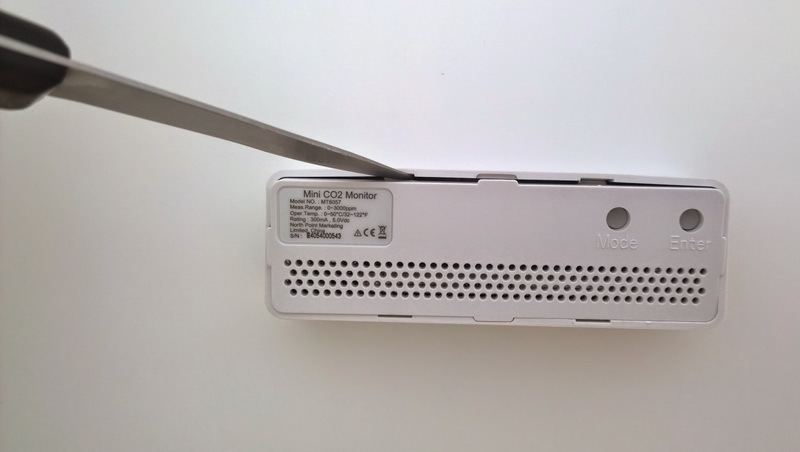
Build quality impressed.
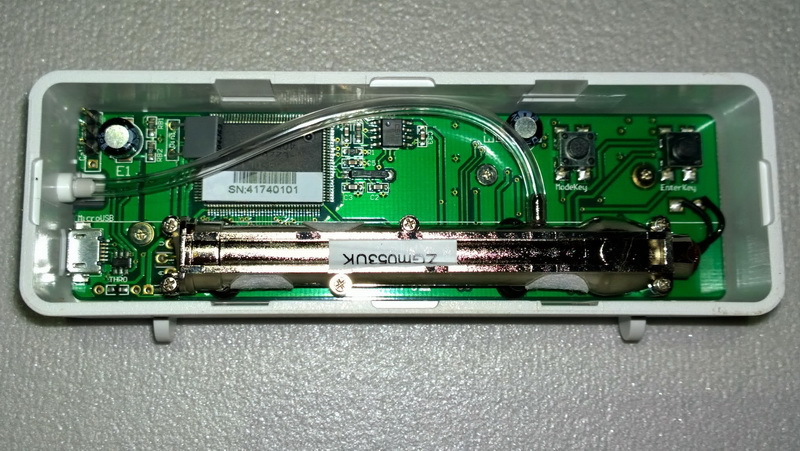
The brilliant cylinder in the far part of the image is the eyes and ears of the device — an optical carbon dioxide sensor that uses non-dispersive infrared technology (NDIR).
This device uses a sensor ZGm053UK.
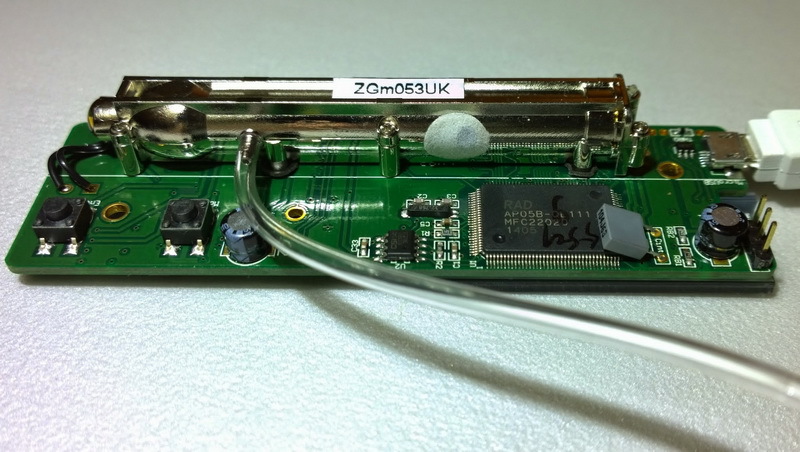
On one side of the sensor is an infrared emitter (in this case, the lamp, but sometimes the LED),
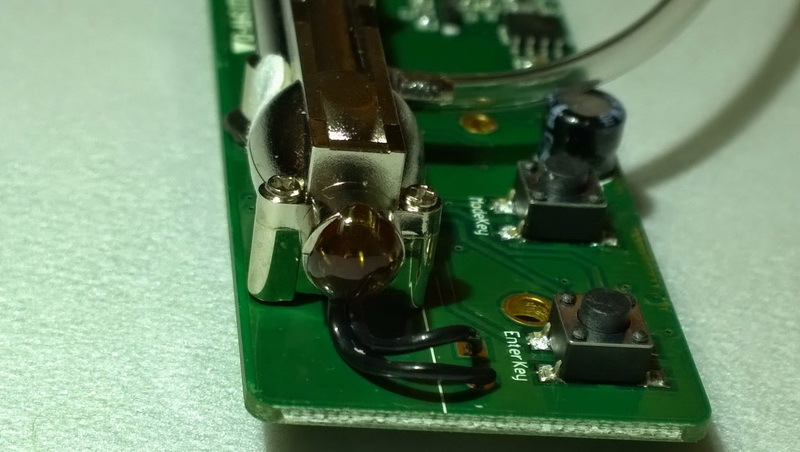
on the other - the photodetector.
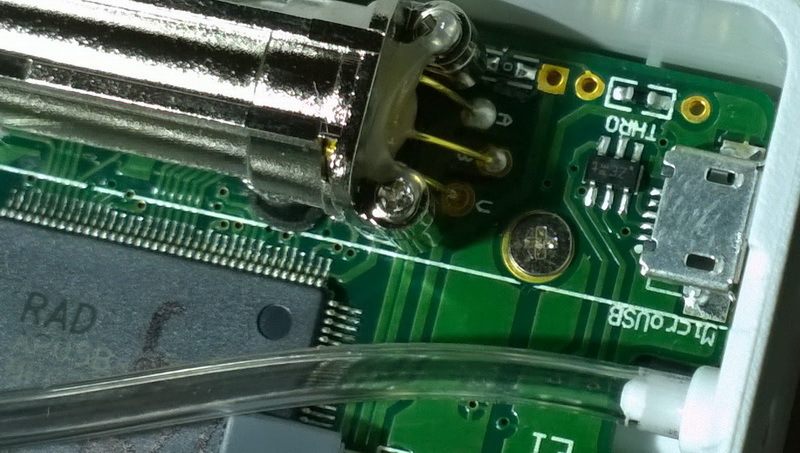
For measurement, the lamp flashes every 5 seconds. In different models, the measurement period is different, for example, for high-speed devices the time is reduced to 0.2 seconds.
You can watch the fascinating warm light of a tube flash forever, but in the video “CO2 meter. Emitter NDIR-sensor "there are only ten.
The lamp is a source of infrared light that passes through a light filter that has a maximum transmission in the wavelength range that we are interested in (in some models, the filter is installed in front of the photosensor).
Then the light is divided into two streams, one of which passes through the chamber with the reference gas, and the other through the chamber into which the air from the room penetrates.
The difference in the infrared radiation of the two streams that have reached the photo sensor determines the degree of light absorption, which depends on the concentration of gas for which the device is designed. Since it is the difference that is measured, the method is considered to be fairly accurate and stable.
Each gas has its own absorption spectrum .
Carbon dioxide trapped in the sensor chamber through three filters on the sensor housing or in the calibration tube absorbs radiation with a length of about 4.3 microns.
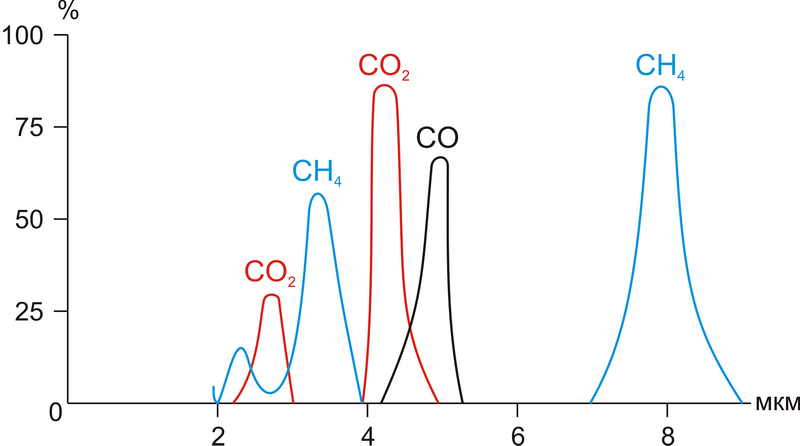
The instrument board is multi-layered, the details are located on both sides, even under the indicator.

On the side of the indicator, the absence of several elements is noticeable, it is possible that this is a binding of the humidity sensor for another modification of the device.

In vino veritas, in aqua sanitas
After reading SkazochNik’s comment on the first part of the article:
... I will try to let in wine.
thought why not? Moreover, the apple wine was intensively prepared , and fermentation is the process by which, in addition to the required product, carbon dioxide is released for the next shock test of the device.
A small installation was assembled in which the gases passing through the water seal were collected. The gas entered the transparent container where the carbon dioxide meter was located. The meter was connected to a computer to record the process graph.
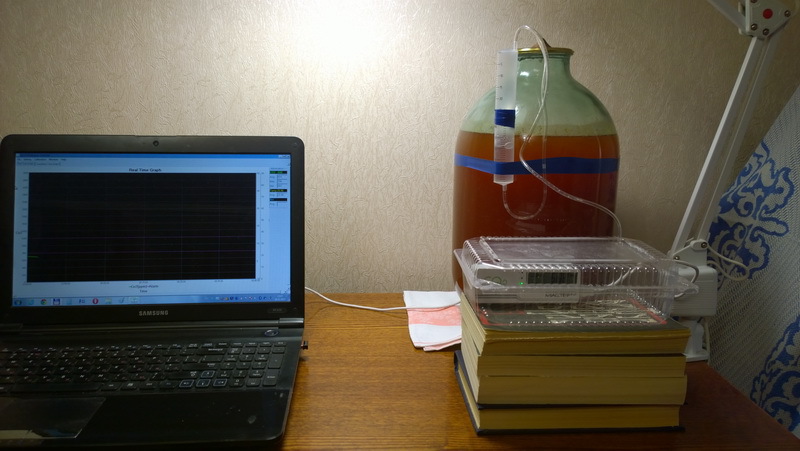
Before the experiment, it was assumed that the emitted carbon dioxide would fill the tank, and the schedule, as well as at the meeting mentioned in the second part of the article, would penetrate the ceiling of the instrument's upper limit of measurement.
The question was only how quickly this will happen?
The room is ventilated, the meter is placed in a container, the program is running, the tube from the water seal is attached to the container ...
Less than a minute later, the schedule rushed sharply upwards. It became uninteresting, because with such a growth rate, it will go beyond the upper limit after 15 seconds. But then something strange happened. Just before the “ceiling”, the chart abruptly changed direction and began a strictly horizontal movement at the level of 2698 ppm.

Apparently, carbon dioxide “flowed” through a small hole at the point of entry into the container of the USB cable.

In order to reduce leakage, after 30 minutes of the experiment, a “hermetic sealing” was carried out with a food film, after which the concentration should have been at least slightly, but increased.

But, the level is still not changed by one ppm and remained strictly on the value of 2698 ppm.

Either the sealing was not very high quality, or it was not only carbon dioxide that came out of the can. The second assumption is closer to the truth, because the outgoing gas smells and carbon dioxide does not smell.
About one o'clock in the morning I went to sleep, closing the door of the room, where only the bacteria in the wine remained.
Waking up at 4:18, did not notice any changes in the graph and removed the meter from the container, placing it on the table. Now he controls the concentration of carbon dioxide in the room. He closed the door to the room and continued to sleep.
In the morning, at about 6:50, the door to the room was opened, but they did not enter it. In this case, you can observe the average background carbon dioxide in the apartment.
At 7:29 the experiment was completed. The result is shown in the graph.

For lovers of the exact sciences in the text file “ Fermentation Data ” are 3-second measurement results. CSV file.
Findings.
1. The meter really works and allows you to see the invisible.
2. It is possible to determine the presence of respiration in many living organisms.
3. Thanks to the instrument, the concentration value is quite simple to determine and must be used in life. Both for the prevention of diseases and for those already sick, in order to identify the cause of the indisposition. Someone does not need this, but it will be interesting for those who are interested in health, causes, effects.
A carbon dioxide concentration sensor can improve the indoor microclimate or at least exclude the effect of increased carbon dioxide concentration from the list of possible causes of poor health.
For many people, the senses and logic work perfectly well; those who do not have this, the device can become a good helper.
4. The indicator can be connected to a computer to record measurement results for further analysis.
According to the schedule, it is possible to determine the characteristics of the room - the adequacy of the air volume, how quickly carbon dioxide fills up when one or several people appear, how quickly the air situation improves after a person leaves the room, what concentrations are achieved, etc.
The nature of the ventilation system can be determined by the nature of the change in the carbon dioxide concentration graph.
5. Carbon dioxide is necessary, but good should always be in moderation. Sensitivity to the concentration of carbon dioxide in humans is individual and depends on many factors, including other parameters of the air and the state of the body. Some employees work (get used to it?) At a concentration of 1700 ppm, I have a desire to open a window at 600 ... 700 ppm. Someone faints when the others continue to stand.
6. Thanks to the measurements, you begin to realize the need for a normal air volume and the correct operation of the ventilation system. Perhaps the saying that people behave prudently only when they have exhausted all other possibilities will cease to act?
7. The indicator can use flower growers and gardeners to monitor plants and create optimal conditions for their growth.
8. Devices that participated in the experiments have different serial numbers - a trifle that inspires confidence.
9. The old window with slots should be valued higher than modern plastic. Or in a different way - a plastic window has a lot to strive for.
10. It is necessary to be closer to nature (where the concentration is in the region of 400 ppm). For the city dweller you can organize a healthy sleep on the balcony.
11. The largest producer of oxygen is phytoplankton, performing photosynthesis in the seas and oceans. Therefore, we must be closer to this nature.
12. The simplest ways to improve the ventilation of rooms:
- clean the grid on the exhaust grille of the ventilation channel (a case a few days ago, when the level of carbon dioxide slowly decreased during ventilation);
- adjust the window sash so as to form a small gap;
- use doors without a lower threshold;
- do not completely close the door;
- Do not close all windows when the air conditioner is operating.
A lot of photos - instructions for working with the device and its main technical characteristics, measurement results, printed circuit board and work schedules are given in the album “ Carbon Dioxide Meter ”.
Green lights at the traffic lights of your indicators!
Reference to the acquisition, software for connecting to a computer, description and technical characteristics of the carbon dioxide detector MT8057.
PS The GT published an article " A simple way to improve work efficiency and avoid the" wars for airing "in the office, " which describes this indicator.
I fully agree with the title of the article, as it is not easy to convince employees of the need for airing. I hope that with the device it will be much easier.
PPS I received a letter saying that there is a project on GitHub with a program for connecting the device to a computer with Linux.
If anyone has the opportunity, please check the performance and unsubscribe. Link to the project:
https://github.com/dmage/co2mon
Oleg Bulatov, the author of this project, is not registered with Habré, so he can only reply via mail. If you have questions, ask.
Regarding the program wrote the following.
It works for me on Linux, but I cannot be objective, because it was written on my hardware :)
I did not find the normal specification, so something was written at random, something was peeped in the Windows version.
It does not look like the final product, then it was not thought up how it can be beautifully decorated.
There is a program that displays something like
$ ./co2mon
04d9: a052 (bus 3, device 2) path: 1
[0x42] Temperature: 25.2250
And if you run it once a second, you get something like this:
[0x42] Temperature: 25.2250
[0x50] CO2: 1791
[0x56] (unknown): 9321
[0x41] (unknown): 0
[0x42] Temperature: 25.2250
[0x6d] (unknown): 1368
[0x50] CO2: 1791
[0x52] (unknown): 9304
[0x42] Temperature: 25.2250
[0x6d] (unknown): 1368
And next to it are scripts that draw graphs through RRDtool .
What is there for the unknown values come, I have not figured it out. But the numbers of CO2 and temperature turned out plausible.
I did not find the normal specification, so something was written at random, something was peeped in the Windows version.
It does not look like the final product, then it was not thought up how it can be beautifully decorated.
There is a program that displays something like
$ ./co2mon
04d9: a052 (bus 3, device 2) path: 1
[0x42] Temperature: 25.2250
And if you run it once a second, you get something like this:
[0x42] Temperature: 25.2250
[0x50] CO2: 1791
[0x56] (unknown): 9321
[0x41] (unknown): 0
[0x42] Temperature: 25.2250
[0x6d] (unknown): 1368
[0x50] CO2: 1791
[0x52] (unknown): 9304
[0x42] Temperature: 25.2250
[0x6d] (unknown): 1368
And next to it are scripts that draw graphs through RRDtool .
What is there for the unknown values come, I have not figured it out. But the numbers of CO2 and temperature turned out plausible.
PPS A lot of readers ask about the place of purchase of the sensor.
In order not to consider the answer as advertising, it is better to send everyone to the personal masterkit .
About where to download programs for working with a computer. For Lunix, I advise you to try what is written in the previous supplement to the article.
For Windows, the answer was given in the comments to the first article.
PPPS Anton Afanasyev confirms the work of the meter under Lunix. This project was mentioned in PPS
The measurement result can be viewed in real time via the Internet. Link to the chart. When you move the cursor, data is shown, the scale from the bottom allows you to scale the graph and move it. Work in real time, printing in many formats. In general, it is interesting and beautiful!
Explanations
<I started this account on rhcloud.com and made monitoring there.
+ forked Oleg Bulatov’s project and finished it so that it would insert github.com/toxeh/co2mon data into mysql.>
+ forked Oleg Bulatov’s project and finished it so that it would insert github.com/toxeh/co2mon data into mysql.>
Graph in the form of pictures at the time of admission.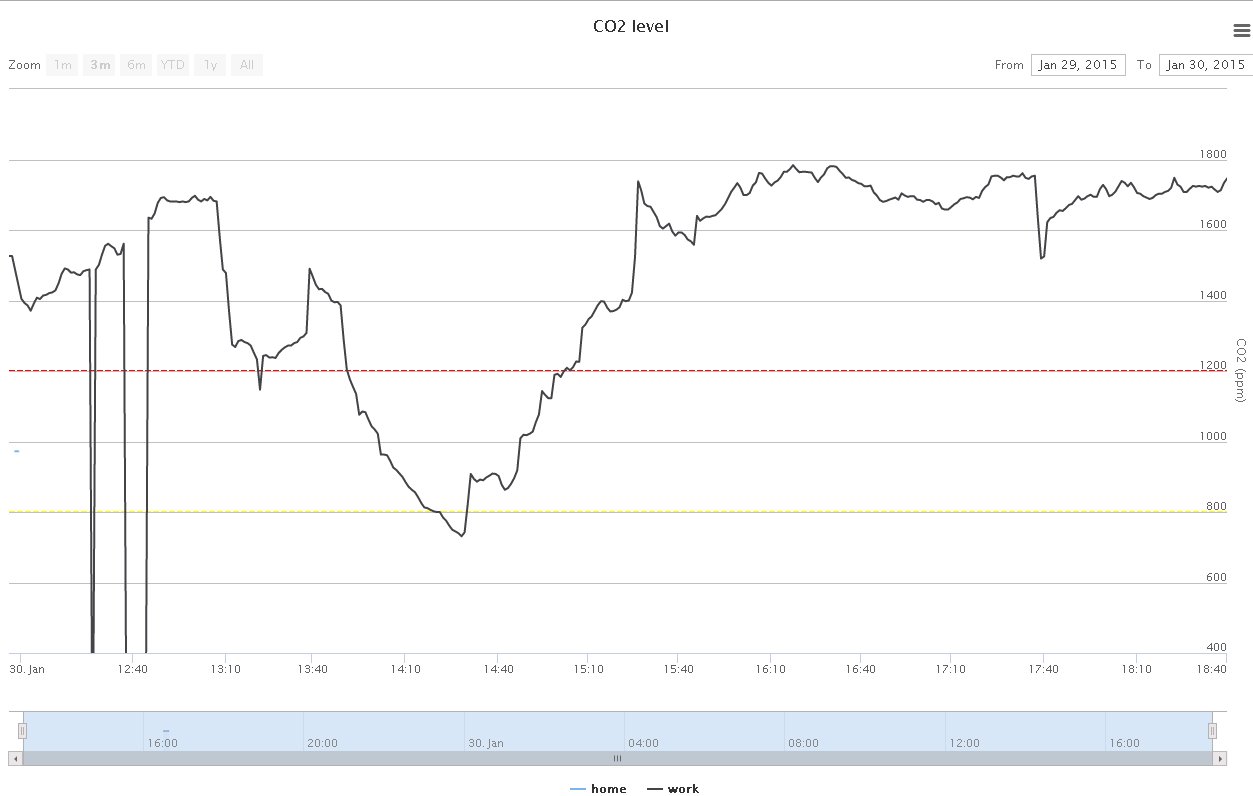

In a few days he is different.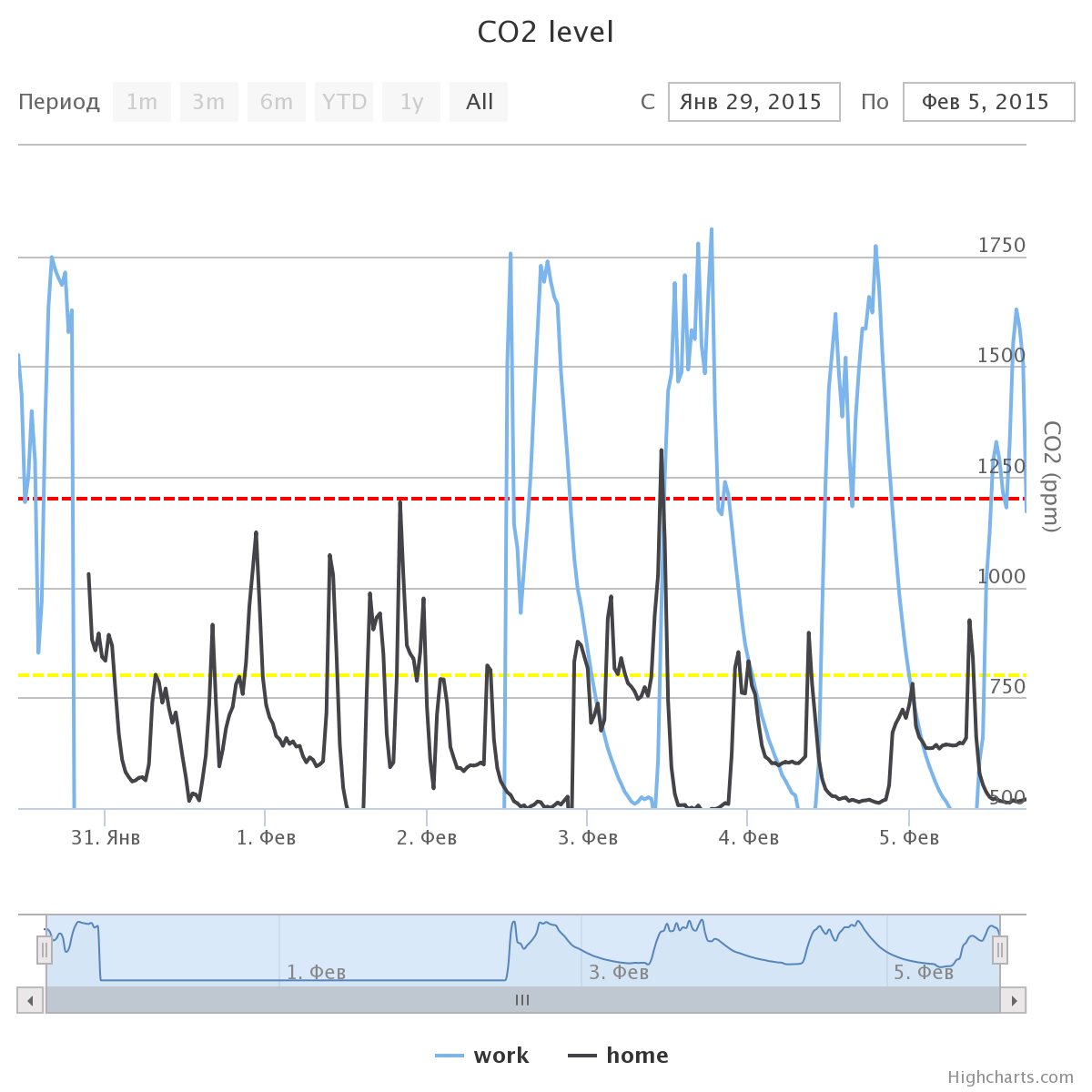

PPPPS Carbon dioxide measurement after several days during fermentation.
On February 9, when the release of bubbles became very rare (from 4 to 15 minutes), a new measurement was made. This time the meter was placed in a plastic bag.
Photo of installation.
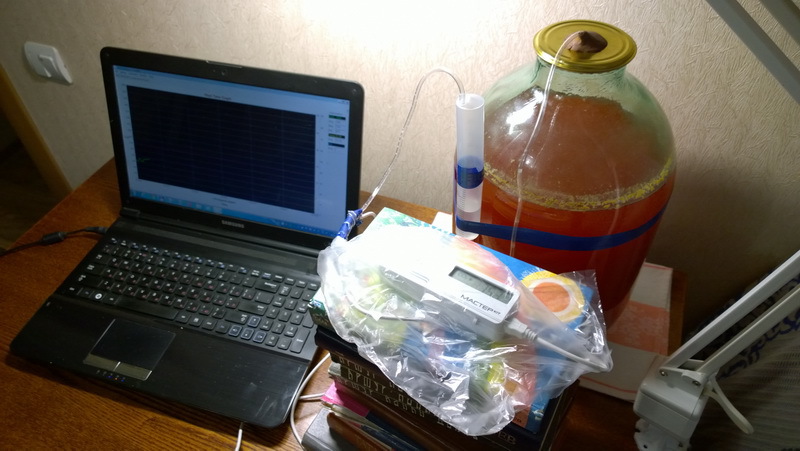
Graph with the result of measurement.
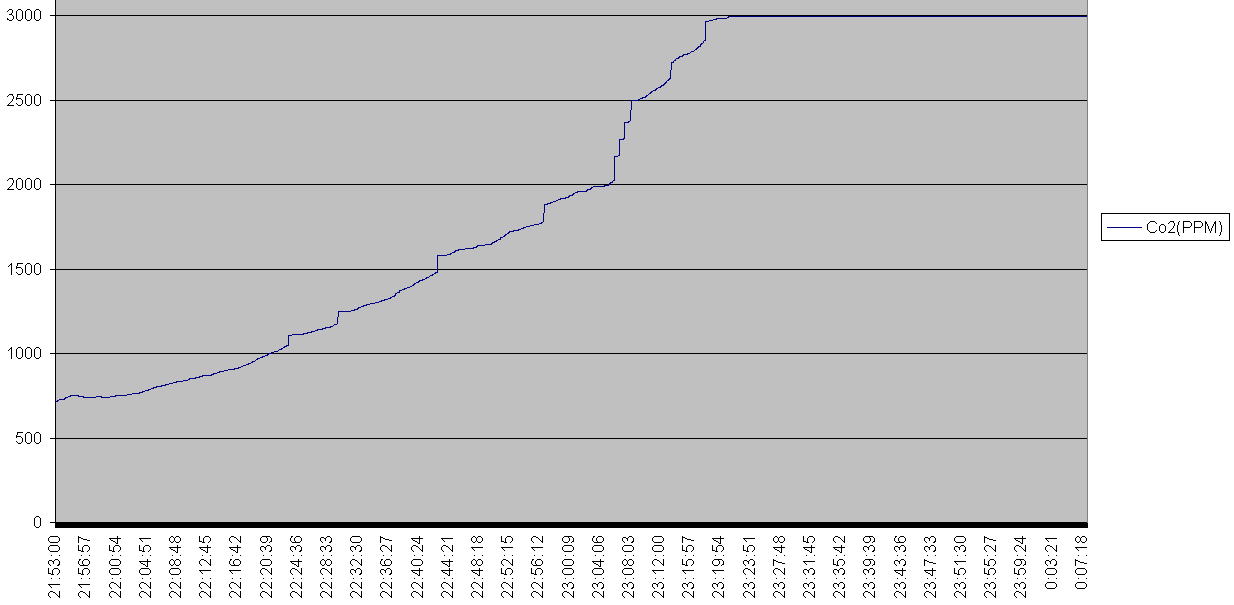
← here →
Source: https://habr.com/ru/post/248403/
All Articles